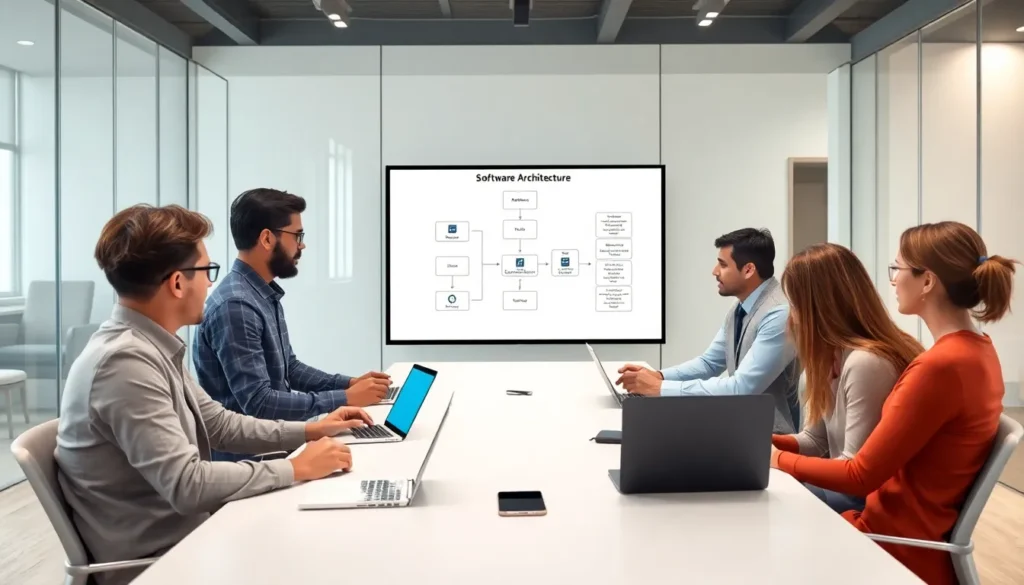Table of Contents
ToggleIn the ever-evolving world of technology, SaaS architecture design stands out like a superhero in a cape. It’s the backbone of countless applications that power businesses, making it essential for developers and entrepreneurs alike. If you’re tired of wrestling with clunky systems that crash more often than a toddler on roller skates, it’s time to dive into the wonders of SaaS architecture.
Understanding SaaS Architecture Design
SaaS architecture design is essential in the tech world, powering a myriad of business applications. Its framework enables seamless integration, scalability, and reliability.
Definition and Importance
SaaS architecture refers to a cloud-based software delivery model where applications are hosted on service provider servers. Users access these applications via the internet, eliminating the need for local installations. Importance lies in its ability to facilitate rapid deployment and easier maintenance. Developers and businesses can quickly adapt to user needs without extensive changes to infrastructure. Security aspects also benefit as leading providers ensure data integrity and compliance, which enhances trust among users.
Key Characteristics
Multitenancy serves as a hallmark of SaaS architecture, allowing multiple users to share the same instance of an application while keeping their data separate. Scalability stands out, enabling companies to adjust resources according to demand easily. Accessibility is another defining feature, as users can reach applications from anywhere with an internet connection. Automatic updates minimize downtime and maintenance efforts, ensuring users always operate with the latest features. Integration capabilities with other services further enhance flexibility and streamline workflows, helping organizations maximize productivity.
Core Components of SaaS Architecture

SaaS architecture consists of several core components that drive its efficiency and functionality. These components work together, ensuring a robust and seamless experience for users.
Multitenancy
Multitenancy is a vital feature of SaaS architecture. This design allows a single instance of software to serve multiple organizations. Each tenant’s data remains isolated, ensuring security and privacy. Cost efficiency increases since multiple customers share the same infrastructure; thus, providers can lower expenses. Scalability is enhanced; as business grows, new tenants can be added without significant changes to the core platform.
Scalability
Scalability plays a crucial role in SaaS architecture. Applications effortlessly handle varying loads, accommodating numerous users simultaneously. Cloud resources can be adjusted to meet demand fluctuations, which is particularly beneficial during peak usage. The architecture supports both vertical and horizontal scaling; vertical scaling involves upgrading existing resources, while horizontal scaling adds more instances to distribute load. With this flexibility, businesses can adapt rapidly to market changes or growth opportunities.
Security Considerations
Security considerations are paramount in SaaS architecture. Data protection measures, such as encryption and access controls, shield sensitive information from unauthorized access. Regular security audits and compliance with industry standards, like GDPR or HIPAA, ensure ongoing trust. Multi-factor authentication strengthens user verification processes, reducing risks associated with breaches. Backup and disaster recovery solutions are also critical, enabling quick restoration of services in case of failures or attacks.
Designing a Robust SaaS Architecture
Creating a robust SaaS architecture requires careful planning and adherence to best practices while avoiding common pitfalls. This ensures efficient application performance and user satisfaction.
Best Practices
Establish a strong multitenant design that isolates data for every organization. Leverage cloud scalability to dynamically adjust resources based on actual user demand. Implement security measures such as encryption and multi-factor authentication to safeguard sensitive information. Regularly perform audits to ensure compliance with data protection regulations. Emphasize integration capabilities, allowing seamless interaction with other systems and applications. Focus on automatic updates to keep software versions current and secure, enhancing overall user experience.
Common Pitfalls to Avoid
Neglecting performance testing can lead to application lag during peak usage times. Overlooking user feedback often results in features that do not meet actual needs. Failing to plan for disaster recovery can jeopardize service continuity in emergencies. Underestimating the importance of compliance may expose organizations to legal issues and penalties. Additionally, hardcoding tenant data can complicate updates and maintenance, so always design with flexibility in mind.
Case Studies in SaaS Architecture Design
SaaS architecture design showcases successful implementations and valuable lessons learned from real-world applications. These examples illustrate best practices and highlight areas for improvement.
Successful Implementations
Numerous companies leverage SaaS architecture effectively. For instance, Salesforce transformed customer relationship management with its scalable model, allowing businesses to manage customer interactions seamlessly. Dropbox exemplifies a user-friendly file storage solution, offering accessibility across devices while maintaining data security. Zoom has redefined virtual communication with its robust platform that accommodates a large number of users efficiently. All these examples demonstrate how effective SaaS architecture can significantly enhance business operations and user experiences.
Lessons Learned
Evaluating past implementations reveals critical lessons for future SaaS design. Many organizations discovered the importance of performance testing during scaling. Feedback loops proved essential; ignoring user insights often resulted in ineffective features. Prioritizing security measures prevented data breaches, reinforcing customer trust. Compliance with industry standards emerged as a non-negotiable aspect; failures here can lead to penalties. Planning for disaster recovery became crucial; organizations learned the hard way that unexpected outages can severely impact operations. Implementing these lessons strengthens the foundation for successful SaaS architecture design.
Future Trends in SaaS Architecture
SaaS architecture continues to evolve, driven by technological advancements and changing user needs. Companies recognize the importance of staying ahead by adapting their strategies.
Emerging Technologies
Artificial intelligence and machine learning increasingly shape SaaS solutions. These technologies improve data analysis, enhance customer personalization, and optimize operational efficiency. Additionally, serverless computing helps developers focus on functionality without managing servers. This approach reduces costs and simplifies scalability. Furthermore, blockchain integration provides enhanced security and transparency in data transactions. These emerging technologies empower organizations to innovate and streamline their operations.
Predictions for Evolution
The SaaS landscape is expected to embrace greater specialization. Companies may develop niche applications tailored to specific industries or user demographics. Increased emphasis on user experience will drive intuitive interfaces and seamless integrations. Alongside this, stricter data privacy regulations are likely to influence design considerations. The demand for real-time analytics and reporting capabilities is anticipated to rise, allowing organizations to make informed decisions quickly. Overall, a shift towards more flexible, adaptive, and security-focused SaaS architectures will define future developments.
SaaS architecture design is a game changer in today’s digital landscape. By leveraging its core principles like multitenancy and scalability, businesses can achieve significant cost savings and improved efficiency. The focus on security and compliance ensures that user data remains protected while enhancing trust in the service.
As technology continues to evolve, staying ahead of trends such as AI integration and real-time analytics will be crucial for organizations looking to optimize their SaaS offerings. Embracing best practices in design and implementation will enable companies to meet the ever-changing demands of their users and maintain a competitive edge. Investing in robust SaaS architecture is not just a necessity; it’s a strategic advantage for future growth and success.




